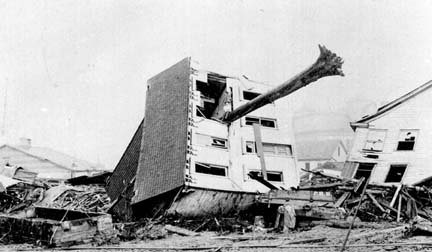Thoughts about the Overall Scheme
To quote myself:It seems that one could begin almost
anywhere, on almost any shelf in the library, and follow trails of
references and
felicitous serendipities. The thing is to begin, and to build an edifice
out of interest and engagement.
The 'anywhere' includes
documents like this one, which can be "read" for their implications, and
treated as stories:

Perhaps the best
known images of the Johnstown Flood are of the John Shultz house. Pierced
by a tree, the house
became an instant icon of the Flood and was a curiosity to many who
traveled to Johnstown to see the devastation of the
flood first hand. Many posed sitting or standing on the trunk of the
tree. The Schultz family all survived the flood.(from
http://www.ctcnet.net/jaha/pages/photos2.htm)
I
want to inspire a degree of personal engagement that seems all too
rare, to get students to pay attention to their own process of learning,
and furthermore to inspire them to pride in their work. Along the
way I want them to think about matters of materials and technologies that
seem to me applicable to (and seem to draw upon) all sorts of
disciplines. The skills developed (including information-finding and
presentation skills) are relevant to just about everything anybody might
do subsequently.
I also want to develop an example of multimedia teaching that other
professors would find interesting, suggestive, inspirational even
--making use of a range of tools not commonly employed.
Ruth Schwartz Cowan's A Social History of American Technology
(Oxford, 1997) still seems the most likely text (see chapter titles and subheadings for the overall
structure), though I don't want to be confined by her definition of
subjects or order of presentation. I'd like each class to center on
something specific and fraught with implications --an image, a person, a
situation, a location, a material, an invention, a process, etc., such
that we begin with that something and end with it as well, and in between
visit all sorts of connections.
